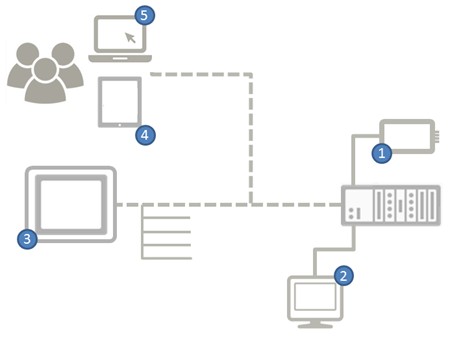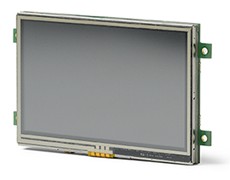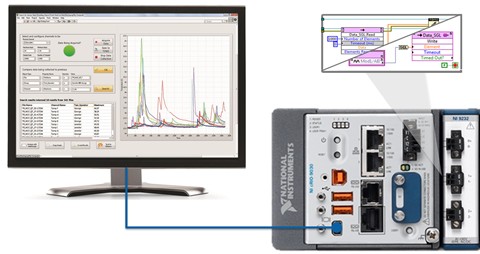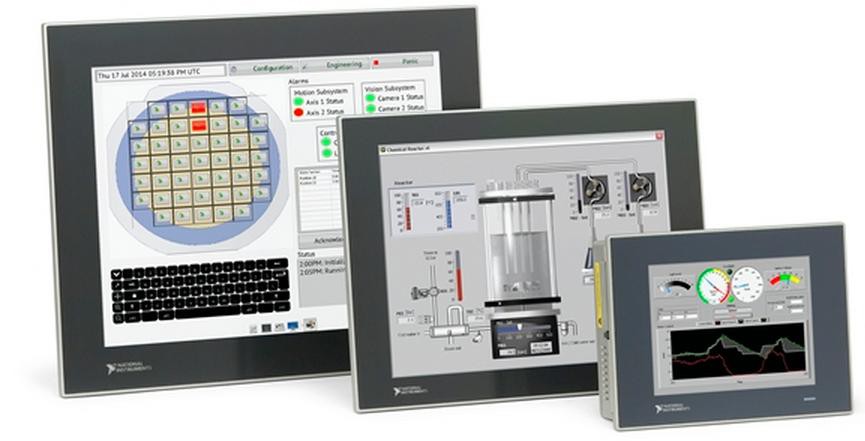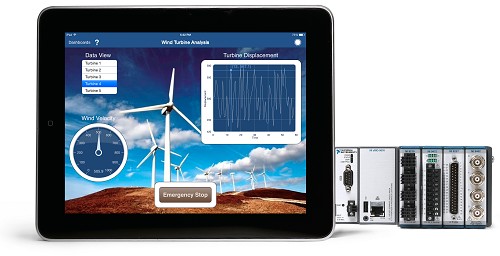Displays and Data Visualization With CompactRIO: The Ultimate Multipurpose Controller
Many control and measurement systems require an operator interface to visualize and interact with the system. Depending on the industry, this visualization tool is referred to as a user interface (UI) or a human machine interface (HMI). When designing a UI or HMI, you can choose from several hardware and software architectures to visualize the data for your system. These architectures can range from local displays, such as component displays or monitors, to a web-accessible remote client making data accessible wherever there is a network connection.
With the CompactRIO platform, you can visualize data and interact with your system using a combination of local, remote, or mobile display options. Whether you are using a simple component display controlled via RS232, a high resolution monitor that connects directly to the controller via DisplayPort, or a remote or mobile web service based thin client, you can design high-quality, interactive, feature rich UIs and connect them directly to CompactRIO for streamlined data visualization and operator interfaces without the need for an additional HMI controller.
Figure 1. With the CompactRIO platform you can visualize your data using a combination of local, remote, or mobile display options.
Display options for the CompactRIO platform can be summarized into two main categories: local and remote. Local display options include component-level displays and monitors. Component-level displays are components to a larger system that you can directly integrate into your final mechanical design. These types of displays are typically board-level, and connect via serial or USB, and are designed to provide more basic functionality such as soft front panel buttons or basic system data. Typically, component displays cannot offer graphics capabilities like streaming video or 1 kHz refresh rates found in OSs like Windows or Linux.
Figure 2. Component-level displays are designed to provide basic functionality such as soft front panel buttons or basic system data, and are usually integrated into your final mechanical design.
Monitors offer a richer UI experience over component level displays. Typically you only find these types of displays paired with a general purpose OSs such as Windows. However, the CompactRIO platform provides the power of a real-time operating system with integrated graphics allowing you to take advantage of the determinism of the operating system and the rich display capabilities offered by a GPU by connecting your monitor directly to the controller via the integrated DisplayPort.
Figure 3. The embedded UI capabilities of the CompactRIO platform eliminate the need for a stand-alone HMI by incorporating it directly into your controller.
For remote visualization and operator interface, there many options that rely on network communication standards such as TCP/IP, UDP, OPC, or web services. These solutions include touch panel computers (TPCs) and thin clients and allow you to separate the HMI from the controller where secure, remote visualization capabilities are needed. TPCs and desktop PCs provide access to more computational processing power due to a dedicated processor driving the HMI application. This type of HMI can drive more complex, graphics-intensive.
Figure 4. TPCs and desktop PCs provide access to more computational processing power due to a dedicated processor driving the HMI application.
Another remote display option is a thin client. Unlike a dedicated TPC or client-installed application, a thin client executes a zero-install UI on the client and relies heavily on the server for data retrieval, analytics, and logic execution. This type of UI allows you to have even more flexibility on where you access your data. Typical thin clients come in two flavors – web browser-based, and mobile. These types of displays are ideal for distributed systems, or when you need to access your data from numerous physical locations.
Figure 5. Thin clients are ideal for distributed systems, or when you need to access your data from numerous physical locations.
Viewing data and interacting with a deployed system is a common requirement in Industrial Internet of Things (IIoT) applications. Using LabVIEW, you can rapidly develop amazing GUIs to for data visualization and operator input. LabVIEW contains a comprehensive set of drag-and-drop controls and indicators such as graphs and charts, meters, buttons, knobs, switches, and many more allowing you to easily create user interfaces for your application and effectively visualize results without having to use third-party components or build views from scratch.
Figure 6. Using LabVIEW you can rapidly develop amazing, feature rich GUIs to for data visualization and operator input.
Next Steps
- Learn more about the CompactRIO Controller
- Learn the basics of a CompactRIO system
- Learn more about building a real-time system with NI hardware and software
- Learn about machine vision and image processing with CompactRIO
The registered trademark Linux® is used pursuant to a sublicense from LMI, the exclusive licensee of Linus Torvalds, owner of the mark on a worldwide basis.
